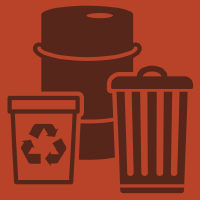Topic Editors

Advances in Organic Solid Waste and Wastewater Management

Topic Information
Dear Colleagues,
The management of organic solid waste and wastewater is a global challenge due to stricter environmental regulations, ecosystem impacts, climate change, and the need to valorize waste. This requires multidisciplinary approaches that provide comprehensive solutions to these complex problems.
This Topic seeks to collect contributions on the most recent advances in organic solid waste and wastewater management. Topics of interest include issues related to wastewater resource recovery, emerging pollutants, development and use of advanced materials, including nanomaterials, green and sustainable technologies, waste to energy or to valuable products, biochar production, advanced oxidation processes, biological nutrient removal, food waste valorization, anaerobic digestion advances, microbial community studies, climate change mitigation, and circular economy among others.
We are pleased to invite you to send your contributions to this multidisciplinary topic. Full papers, communications, and reviews are all welcome.
Prof. Dr. Alejandro Alvarado-Lassman
Prof. Dr. Carlos Velasco-Santos
Prof. Dr. Juan Manuel Méndez-Contreras
Topic Editors
Keywords
- green and sustainable technologies
- waste to energy
- anaerobic digestion
- climate change mitigation
- circular economy
- biomass valorization
- carbon nanomaterials
Participating Journals
| Journal Name | Impact Factor | CiteScore | Launched Year | First Decision (median) | APC | |
|---|---|---|---|---|---|---|

Energies
|
3.0 | 6.2 | 2008 | 16.8 Days | CHF 2600 | Submit |

Materials
|
3.1 | 5.8 | 2008 | 13.9 Days | CHF 2600 | Submit |

Molecules
|
4.2 | 7.4 | 1996 | 15.1 Days | CHF 2700 | Submit |

Waste
|
- | - | 2023 | 34.1 Days | CHF 1000 | Submit |

Water
|
3.0 | 5.8 | 2009 | 17.5 Days | CHF 2600 | Submit |

Sustainability
|
3.3 | 6.8 | 2009 | 19.7 Days | CHF 2400 | Submit |

MDPI Topics is cooperating with Preprints.org and has built a direct connection between MDPI journals and Preprints.org. Authors are encouraged to enjoy the benefits by posting a preprint at Preprints.org prior to publication:
- Immediately share your ideas ahead of publication and establish your research priority;
- Protect your idea from being stolen with this time-stamped preprint article;
- Enhance the exposure and impact of your research;
- Receive feedback from your peers in advance;
- Have it indexed in Web of Science (Preprint Citation Index), Google Scholar, Crossref, SHARE, PrePubMed, Scilit and Europe PMC.
Published Papers (8 papers)
Planned Papers
The below list represents only planned manuscripts. Some of these manuscripts have not been received by the Editorial Office yet. Papers submitted to MDPI journals are subject to peer-review.
Title: WASTEWATER TREATMENT PROPOSAL FROM AN AUTOMOBILE REPAIR SHOP THROUGH COAGULATION-FLOCCULATION AND SOLAR PHOTO-FENTON PROCESSES
Authors: Carlos Javier Escudero Santiago
Affiliation: Universidad Autónoma de Guadalajara. México
Abstract: Mexico is one of the countries with the highest global production of vehicles per year, with 3.7 million units in 2020 (Tetakawi, 2021). Most of the cars manufactured in Mexico are sent to several countries, however, more and more vehicles circulate in the country that require services specific to the industry. According to a 2020 report, in Mexico there are 231,678 establishments dedicated to the repair and maintenance of cars and trucks (INEGI, 2020). In mechanical workshops, there is often a lack of good management of the liquid waste that can be generated from washing, which has high concentrations of fats and oils, presence of dissolved and suspended solids, detergents, remains of antifreeze, brake fluids and power steering, among others. Unfortunately, since there is no control of wastewater from mechanical workshops, it is only disposed of in the soil, contaminating it or, in the best of cases, it is only poured into the sewage system, but then in municipal treatment plants, conventional systems will not achieve completely eliminate the contaminants present. The present study focuses on the search for alternatives for treating wastewater from a mechanical workshop located in the Metropolitan Area of Guadalajara, which is the one that concentrates about 65% of the total vehicle fleet in the State of Jalisco in Mexico. To do this, on the one hand, the coagulation-flocculation process was evaluated, which focuses on the addition of chemical reagents to eliminate colloidal impurities from wastewater. On the other hand, the Fenton and photo-Fenton processes were also studied, which are Advanced Oxidation Processes characterized by the generation and use of highly oxidizing agents (HO●) with the use of iron ions (Fe2+) and hydrogen peroxide (H2O2) in an acidified medium. The photo-treatment of the wastewater was experimented with LED (Light Emitting Diode) lighting, also using a renewable energy source such as solar lighting. The solar photo-Fenton process delivered the best result for the removal of organic matter of the wastewater sample, adjusting the pH to 5, reaching up to 85% removal of the chemical oxygen demand (COD) in 30 min of treatment.
Title: Hydrogen production estimate of a UASB reactor as a pH and Hydraulic Residence rate function
Authors: Albino Martinez Sibaja
Affiliation: /
Abstract: /



